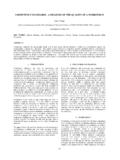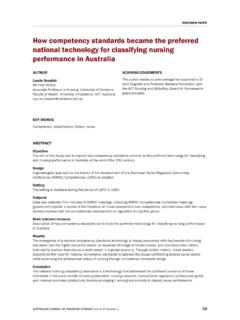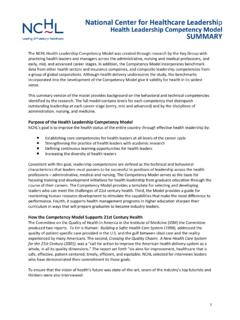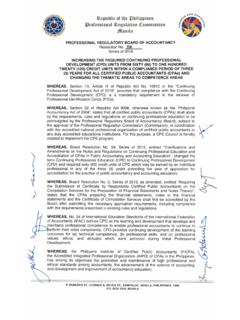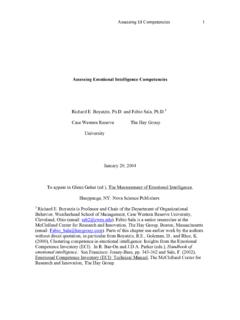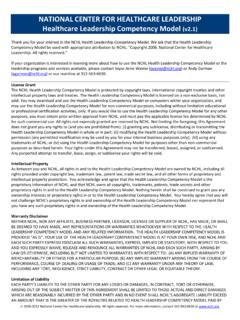Transcription of HSE Human Factors Briefing Note No 2 - …
1 -1- HSE Human Factors Briefing Note No. 2 Competence Briefing Note 1 Introducing Human Factors explains the background to these Briefing notes . Competence is the ability to undertake responsibilities and to perform activities to a recognised standard on a regular basis. Competence is a combination of practical and thinking skills, experience and knowledge Source: Ref. 1 Case study In July 1999, an operator caused an explosion when drying an unstable compound at too high a temperature. The compound involved is dried on trays; the procedure is to collect water from the process in a reservoir, then transfer it to a drain for treatment. A fault in the system overfilled the reservoir, in addition, the water contained too much of the unstable compound. The operator heated the water in the reservoir using a steam pipe to ease the transfer process. After 20 minutes, the reservoir exploded sending a fireball around the installation.
2 No one was injured as this happened at shift change. It was recommended following the investigation that the site needed to improve operator training in the risks associated with the compound, in particular the danger of decomposition when heated. The operator lacked some basic knowledge. This was coupled with a fault in the hardware thus; in common with many accidents, this one had at least two underlying causes. Source: Ref. 2 HSE concerns You should have a process to ensure that anyone working with major hazards on your site is competent. (See box below & Ref. 3). You should link the competence assurance process to your major accident risk assessment. First, identify hazards on your site. For example, for a particular hazardous material, you should identify related critical tasks . That is, find out what your workforce must do to control the material (keep it contained) and what to do if it is released (abnormal or emergency situation).
3 Then, you must ensure that your workforce has the skill, knowledge and experience of the material and the processes using it to carry out their critical tasks. Remember that managers have critical tasks too. The NVQ/SVQ system can provide some general and some site-specific competencies, but is not usually linked to major accident hazards. You should modify your VQ system to make this link. You should consider the type of procedures needed based on competence. Generally, the type of procedure needed (detailed vs basic job aid) will depend on whether: the person doing it is competent and whether the task is safety critical, infrequent and complex. (See Briefing Note 4 on Procedures). -2- We need to know that your company has competent employees: people who have the skills, experience and knowledge to do their job properly and safely under all working conditions. The diagram on page 2 shows the three main things you need to do to make sure your staff are competent: Select the right people Train them Assess them (at various stages) These three stages together form the competence assurance system of the company.
4 Note: these are continuous not one-off processes. Learning more about competence Competence checklist The list below outlines how good companies approach competence. At this site we: Know all hazards that could arise in every task (including normal operational, maintenance and emergency tasks) Have a good selection process to identify suitable employees or contractors for those tasks Know the exact type of person to assign to each task Have enough people to always be able to put the right person onto a particular job Can identify any gaps in a person s skill or knowledge or experience (competence) Know the best way of providing the skills and knowledge that people need ( training, including on the job) Have access to the best training resources (training facilities, trainers and equipment) Make it easy for people to get the training they need Always use actual work instructions/procedures in our training Continually improve managers as well as staff competence Never make a person do a job they re not competent to do Assess whether training has worked Retrain people if they need it Keep good records so that we know what training/experience each person has had and what they need next Change the selection, training and assessment system if it isn t working A tick in every box above would suggest you are a world-class site when it comes to competence.
5 Are you really so sure that you do all of these things? In particular, can you honestly say that your competence assurance scheme takes account of major accident prevention and recovery? Competence Management selection, training and assessment process Selection: Is candidate suitable for activity?Train and develop candidateAssessment: Is person competent Monitoring: Is competence being maintainedReassessment:Is person competent? Is person suitable for development programme? Not suitable for activity Retrain: Is person suitable for more training?Not suitable for activity Person on development programme Assess candidates: select or reject Train/give job experience Assess candidates after training/time on job. Retrain or reject competentnot yet Yes YesYesYesYesYesno no nonono Continually assess, develop and train or reject External or internal candidate for activity A Competence Management System Our guide, Developing and Maintaining Staff Competence is a useful text on the subject.
6 It was written for the rail industry but applies equally well to many other industries. On this page, we set out the main points of that document and others on the subject of competence management. The guidance document describes how to design a Competence Management System (CMS). This is a 15-step process; the diagram below shows the main elements. The comments and questions near the boxes below are intended as prompts about things you should consider in developing your own CMS. -3- Identify what could go wrong in a job that could lead to a major accident. What controls do you have? Develop standards for measuring jobholders on safe performance. ESTABLISH REQUIREMENTS FOR THE CMS identify activities and assess risks select standards AUDIT AND REVIEW THE CMS verify and audit the system review and feedback DESIGN THE CMS develop procedures and methods decide how to meet the standards establish requirements for training, development and assessment maintain managers competencies MAINTAIN COMPETENCE monitor & reassess staff performance update the competence of individuals manage sub-standard performance keep records IMPLEMENT THE CMS select and recruit staff train, develop and assess staff control activities undertaken Is the CMS working?
7 What measures of performance do you use (safety reports, assessments of jobholders)? You need an independent view of any problem areas. Use this to continually improve the system. Develop procedures for using the CMS. Is it clear what everyone needs to do to make it work? You must decide on the methods to use to make sure that jobholders meet the company s competence standards (how to select, train and assess staff and contractors). You will need to monitor managers competence in their job and in using the CMS. Jobs change and technology changes so keep reviewing and upgrading the CMS Continue assessing jobholders. Do this through planned observations and surprise visits . Are jobholders competent in emergencies? Have you run emergency exercises (realistic drills or classroom-based table-top exercises?) Are your assessors competent to assess employees and contractors? You will need methods to improve competence or, ultimately, procedures to remove jobholders who continue to fail to meet standards.
8 Explore all the reasons for loss of competence are they to do with the job (changes in methods or equipment), the individual ( personal problems, attitude, aging, injury) or the organisation ( culture, failures in the CMS). Record jobholders current level of competence and use this as a tool for planning new and refresher training, job experience, further assessments and promotions. How will you identify the right kind of people? Do you have a written job description for the post? Does it specify safety-related aspects of the job (hazards to the jobholder and hazards that he/she could create or might have to manage)? Select using application form details, interview and tests. You may need written and practical tests. The aim is to find out the candidate s existing level of job-related and hazard-related knowledge skill and experience. There won t be a perfect match so you will need to train and assess the person selected.
9 After training, continually assess their performance via supervisor/mentor or other colleagues reports. Organise structured on the job training; allow hands on experience of work situations; measure against standards so you will know when to move them to the next stage of their development. Make it clear what jobholders are not yet allowed to do. References 1. Developing and Maintaining Staff Competence. HSE (2002), ISBN 0 7176 17327 2. Major Accident Reporting System (MARS) HSE (1999) Major Accident Prevention Policies for Lower-Tier COMAH Establishments. Chemical Information Sheet No 3. HSE Books, PO Box 1999, Sudbury, Suffolk CO10 6FS -4.










